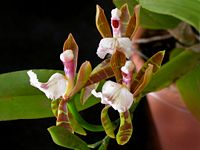Aspasia (orchid)
| Aspasia | ||||||||||||||||||||
|---|---|---|---|---|---|---|---|---|---|---|---|---|---|---|---|---|---|---|---|---|
 Aspasia epidendroides
| ||||||||||||||||||||
| Scientific classification | ||||||||||||||||||||
| ||||||||||||||||||||
| Type species | ||||||||||||||||||||
| Aspasia epidendroides Lindl. 1832 | ||||||||||||||||||||
| Species | ||||||||||||||||||||
| ||||||||||||||||||||
| Synonyms | ||||||||||||||||||||
|
Aspasia is an orchid genus closely related to Miltonia and Brassia formed by seven comparatively large species spread from South of Mexico to South of Brazil. Aspasia species have few medium size flowers of exquisite colors which are occasionally cultivated or used to produce artificial hybrids.
Distribution
Aspasia exist in four different areas of Central and South America:
Two species inhabit primarily Central America the most common is Aspasia epidendroides, that ranges from Mexico to Colombia from sea level to 1,100 meters of altitude but much more common up to 400 meters; and Aspasia principissa, from Colombia to Costa Rica from sea level to 600 of altitude but much more common up to 150 meters. Also from exclusively from Colombia is Aspasia omissa. Aspasia psittacina, endemic in Ecuador, can be found from sea level to 750 of altitude but much more common up to 300 meters. Aspasia variegata is from all amazonic region from 200 to 1300 meters in Bolivia. The last area occupied is Brazilian southeast and south, reaching Bolivia and Paraguay, from 200 to 750 meters, by Aspasia lunata; and Aspasia silvana exclusively Brazilian Serra do Mar, from Rio de Janeiro to Bahia.
Some species are exclusively epiphyte on the thick stems of the trees a low height, others live on branches where they get more light, while a few can also be found living over rock grooves covered by fallen leaves in shady and humid forests where they never are exposed to straight sunlight.
Description
Aspasia is a genus of comparatively robust plants intermediate of Brassia and Miltonia, to which it is morphologically closer and can be distinguished because its flowers show the labellum partially fused to the column.
Aspasia species are characterized for ofter showing am elongated rhyzome, with thicker roots than Miltonia, with more elliptical or elongated and highly laterally flattened pseudobulbs, protected by some foliar steaths shorter than the leaves, and one or two apical leaves. These are articulated, basally conduplicate, ligulate sometimes with acute apex, thin and narrow, very malleable, light green colored. A inflorescence is erect or arching, shorter than the leaves and bares one to nine flowers sometimes showy. The inflorescence shoots from behind the foliar steaths at the pseudobulbs bases.
The flowers vary according to the species. The petals from more elliptical to more acute, in some species wider than the sepals, in others narrower or similar in size and shape, from flat to concave. The labellum is fused to the inferior half of the column, seeming to emerge from there and thereafter becoming much wider; the blade varies from slightly to clearly three lobed, flat or reflected, fleshier on the center and there showing calli or salient veins. The column is elongated, with or without small inferior auricles and present a large apical anther with two hard yellow pollinia, stipe and viscidium.
When these species are used to produce artificial hybrids, the characteristic that seems to predominate is the few amount of resulting flowers by inflorescence, prevailing even over the so floriferous Oncidium.
Despite being easy to grow Aspasia species tent to be subject to spots on their thin leaves generally caused by fungi proliferation. They should never be exposed to full sunlight. They are not much sensitive to temperature but it varies according to their origin A. lunata being the one that grows cooler and A. principissa the warmer grower all under intermediate or warm temperatures. It is important to verify the conditions of culture to each species as they come from different environments. Despite they show a rest period after blooming, Aspasia always need to be watered, more abundantly during active growth. They need at least 75% of humidity and good ventilation all the time. Moderate weekly fertilizing with a balanced formula is beneficial during active growth. They may be potted in a compost of half-chopped Sphagnum, vegetable fiber, and some medium sized lumps of charcoal, or mounted on plaques of vegetable fiber, however if mounted they will need more frequent waterings.[1]
Taxonomic notes
The genus Aspasia was proposed by John Lindley in 1832 when he described its type species, Aspasia epidendroides. The name of the genus is a reference to Aspasia of Miletus a friend of Pericles.
Species
Aspasia epidendroides Aspasia lunata Aspasia principissa Aspasia omissa Aspasia psittacina Aspasia silvana Aspasia variegata
References
- ↑ Baker, Charles O & Baker, Margaret L. (2006), Aspasia in Orchid Species Culture Oncidium/Odontoglossum Alliance: 35-42, Timber Press. ISBN 9780881927757